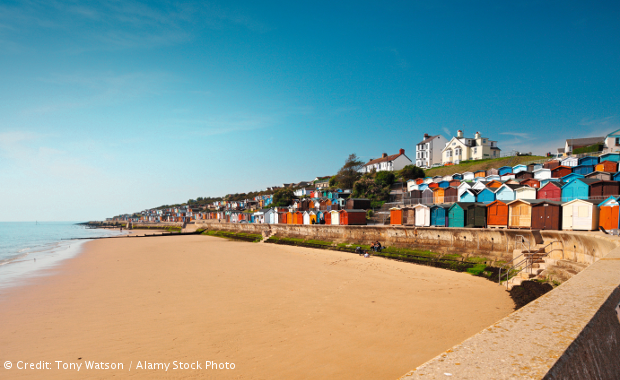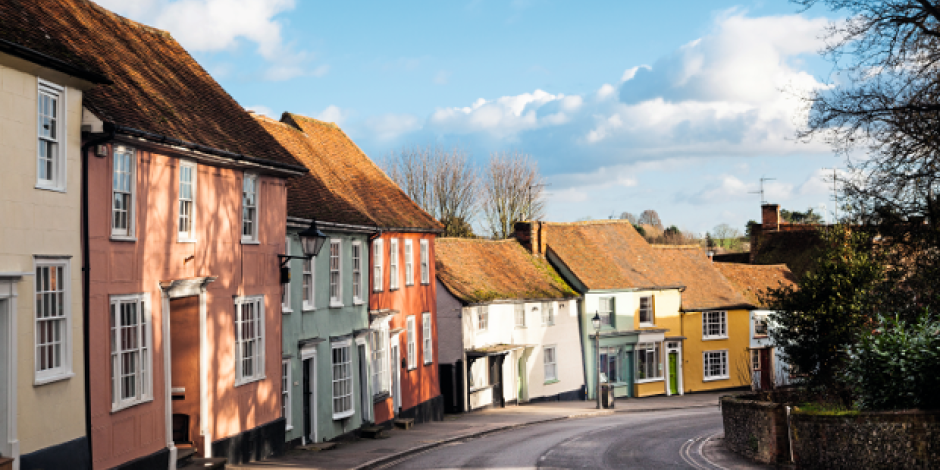I watch from a hill as the sun breaks through the mistfeiner Nebel, Dunstmist on the Essex border. The tower of St Mary’s Church, Dedham, stands tall across the valley, and the River Stour winds like a silver snake through fields of grazinggrasendgrazing cattleViehcattle and sheep. This timeless scene was well known to John Constable (1776–1837), one of Britain’s finest landscape painters. Constable grew up here, and a look at his Dedham Vale of 1802, painted close to where I stand today, shows just how little the countryside has changed in more than 200 years.
Constable believed that the landscape should be experienced en plein air, so I pull on my walking boots and take one of the many trailWanderwegtrails through Constable Country. The Stour Valley is typical of ruralländlich, dörflichrural Essex: hedgerowHeckehedgerows, farmland, wildlife and water. Essex doesn’t really have hills (it has a high point of just 147 metres), but it does have big skies, which rise above me as I walk the gentle three kilometres to Dedham.
The village appears to be a centre of calm when I arrive, with its historic church, millMühlemill and arts centre all close to the river. I stop at the 16th-century Essex Rose tea house and order a Tiptree apple juice, produced by Wilkin & Sons, Essex fruit growers since 1885. “It’s not always this quiet,” says the waitress. “In summer, we get a bit overrun by cars and tourists.”
The name “Essex” comes from the “East Seaxe” kingdom of Saxons, who settled here around AD 500. With deep historical and cultural roots, Essex is a largely rural county. Yet it struggles to throw off the label of the “dustbin (UK)Müllhaldedustbin of London”, a place for the capital’s unwanted waste, industry and overspillÜberbevölkerungoverspill population. The stereotype of an “Essex girl” (or “boy”) is of someone who celebrates materialism and ignorance. It’s a view promoted by TV reality shows like TOWIE, The Only Way Is Essex, set in the shops, bars and clubs in and around Brentwood, which is close to London.
Castles and spacecraft
Colchester, my next stop, promises something different. A sign declares this to be “Britain’s oldest recorded town”, so I head for the Museum Quarter to learn more. Colchester Castle sits in landscaped gardenLandschaftsgartenlandscaped gardens, not far from the high street and its shops. With the remains of a Norman castle and the largest keephier: Burgfriedkeep in Europe, the building today houses an impressive museum.
The displays all have stories to tell, explains my guide, as she points to Roman tileZiegeltiles and stones visible in the castle walls. She tells me how, after the Romans invaded Britain in AD 43, Colchester, then known as Camulodunum, became a centre of power. In AD 60, Boudicca, queen of the Iceni, led the Celts in revolt and destroyed much of the town. Camulodunum was rebuilt, however, and many Roman remains are visible today, including temple ruins and town walls.
The next day, I’m back in the Museum Quarter to visit a very different type of building. Shaped like a crescentHalbmondcrescent, Firstsite is covered in copperKupfer-copper-aluminium sheeting(Blech)Verschalungsheeting, which makes it shine like a spacecraftRaumfahrzeugspacecraft in the morning sunshine. This exciting new art gallery and cultural centre would not look out of place in any major city. Inside, its light-filled galleries include Essex curiosities in the “Wunderkammer” and a special exhibition of tapestryWandteppichtapestries and ceramics by Essex artist Grayson Perry.
After lunch, I wander in and out of high street shops, and past the grandiose Victorian town hallRathaustown hall and clock tower. At Balkerne Gate, I see Jumbo, a giant Victorian water tower built with more than 1.2 million brickZiegelsteinbricks. There is talk of a rooftop restaurant opening here, but for the moment, Jumbo remains empty, and I have to look elsewhere for my evening meal.
Right on the “naze”
From Colchester, I drive east the next morning. As the landscape opens up into farmland and fields, it feels as if I’m heading towards the edge of things. Walton-on-the-Naze (“naze” is the Old English word for “promontoryFelsvorsprung, Landzungepromontory” or “nose”) is a seaside town dominated by the second-longest pier in Britain. Not much of it is visible when I arrive, as the coastline is to shroudverhüllenshrouded in fog. Ice cream kiosks, takeaways and seaside shops to huddle togethereng verschachtelt stehenhuddle together along the seafront. The sandy beach is empty except for someone walking a dog.
After a short drive north, I park at the Naze Centre on the clifftopFelskuppeclifftops. It’s ideal for birdwatching at Hamford Water National Nature Reserve, an important site for waderWatvogel, Stelzvogelwaders and water birds. Not far from the cliff’s edge is the 26-metre tall, red-brickBackstein-red-brick Naze Tower. Dating from 1720, this elegant eight-sided structure was built as a navigational beaconLeuchtturmbeacon for shipping. Today, its eight floors house a museum, tearoom, art gallery and viewing platform. The spectacular 360-degree panorama is reason enough to climb the 111-step spiral staircaseWendeltreppespiral staircase. On a clear day, it is possible to see 50 kilometres into the distance. Today, it’s more like 50 metres, but I can see that the tideGezeitenströmungtide is close to the shoreKüste, Ufershore.
There’s just time for a quick walk along the sandy beach. The cliffs are filled with fossils, and it is common to find ancient sharkHaifischsharks’ teeth, whalebone, shellMuschelshells and fossilizedversteinertfossilized wood washed up on the shore.
After only half an hour, I have to turn back, as the incoming tide is already touching the steps that lead down to the beach. The fog adds to the eerinessUnheimlichkeiteeriness of this isolated headlandLandspitze, Landzungeheadland. Surrounded by the sea on three sides, its stillness is broken only by the sound of the waves and distant bird calls.
Back at the Naze Centre, I chat to Peter, a volunteerFreiwillige(r)volunteer with the Essex Wildlife Trust. I show him my fossil finds, which he identifies as twig(dünner) Zweigtwigs from around 54 million years ago. He laughs when I tell him that I visited Walton as a young child. “The beach you played on then is probably 100 metres out there now,” he says, pointing towards the sea, and explaining that this stripStreifenstrip of coastline erodes by up to two metres each year.
The sea is not the only erosion risk Essex faces. Peter tells me that he grew up in Dagenham, once an Essex town but now part of Greater London. to boundbegrenzenBounded by the River Thames to the south and London to the west, Essex is being to nibbleknabbernnibbled away like a biscuit by the capital’s appetite for growth.

Beach huts and ghosts
Immediately adjacentbenachbart, angrenzendadjacent to Walton, Frinton-on- Sea is an old-fashioned but charming seaside town. It has a reputationRufreputation for being conservative and resistant to change: Frinton’s first pub did not open until the year 2000, after years of opposition. But as I walk along Connaught Avenue (Frinton’s main shopping street, once known as the “Bond Street of the East Coast”), it’s clear that this is a place that is proud of its appearance. Down at the seafront, the sun comes out to show Frinton at its finest: the sea, a wide promenade, the clean, sandy beach and rows of colourful beach huts.
After breakfast the next day, I’m off to explore an Essex hideawayZufluchtsort, Versteckhideaway: Mersea Island. The Strood, built on an ancient Roman causewayFahrdamm, Damm(straße)causeway, is the only road in and out, and it is said to be to hauntheimsuchenhaunted by the ghost of a centurion. Mersea is truly an island only when the tide covers the road twice a day, for one week each month. But as soon as I cross, I can feel the sense of isolation.
Popular with artists and writers, Mersea Island is Britain’s most easterlyöstlichste(r, s)most easterly inhabited island. At West Mersea, I discover an appealing mix of seaside tourism and working boatyardWerftboatyards. The air is filled with the smell of mud, seaweedMeeresalgen, Seetangseaweed and salt. The seafood industryMuschelzuchtshellfish industry has a long history here, and fresh fish is available on the quayKaiquay, where people queue for boat trips. Mersea is a place for seafoodMeeresfrüchteseafood lovers, and the island makes its own wines and beers.
There’s just time to explore quieter East Mersea and to buy some bottles of local beer before heading back across the Strood. When I look back, I see a shadowy figure. Could it be the ghost of the Roman soldier? Or is it a lone hikerWanderer, Wanderinhiker? My mind full of myths, I reach the mainland safely and drive westwards towards historic Maldon.
Located on the Blackwater estuaryMündung(sgebiet)Estuary, Maldon was once an important Saxon port. A waterfront monument tells of the Battle of Maldon in 991, in which the locals were to defeatbesiegendefeated by the Vikings. At Hythe Quay, I spot some of the famous Thames sailing barges. Their job today is mainly to transport tourists. I wander uphill to explore the shops and enjoy the medievalmittelalterlichmedieval and Georgian town centre. There’s one thing I have to buy before I leave: Maldon sea salt, a must-have for our kitchen at home. Tired, I make the halfhour drive to my overnight stop Chelmsford, the administrative centre of Essex.
Fine art and seals
Chelmsford is the birthplace of radio and the location of Marconi’s first public broadcastSendungbroadcast in 1920. There’s no time to start exploring, however, because for my last full day in Essex, I have one simple aim: to walk on water. To do so, I catch a morning train to Southend Victoria station. Just around the corner, Southend Museum and the Beecroft Art Gallery offer me a perfect introduction to the town. “Most people head straight down to the seafront,” admits the assistant curator as he greets me like a long-lost friend.
A walk through the town centre brings me to Royal Terrace, where I look out across the rideFahrgeschäftrides of Adventure Island and seafront amusements, along the lines of the famous pier and far across the Thames Estuary towards the shoreline of Kent.
Six million visitors go to Southend-on-Sea every year, and most of them want to see the world’s longest leisure pier there, which extends no less than 2,158 metres into the stretch of low water that is neither fully river nor sea. Back in 1829, the idea was to allow steamboats access to the pier head even at low tide — when the sea goes back one and half kilometres from the beach.
At the pier entrance, I climb on board the “Sir John Betjeman”, a narrow-gaugeSchmalspur-narrow-gauge railway engine (UK)Lokomotiverailway engine named after the former poet laureateHofdichter(in)poet laureate (“The Pier is Southend, Southend is the Pier,” Betjeman once wrote). What the train to lackvermissen lassenlacks in vintage style it more than makes up for in views. It takes just ten minutes to ride peacefully along the pier, watching the waves through the windows, white horses racing towards us.
Outside, there’s a strong breeze blowing, and the salty air to snapreißensnaps at my hair and clothes, throwing sea spray across the wooden boards. Walking the last few metres to the lifeboat stationRettungsstationlifeboat station at the very end of the pier, I am surprised to see a large grey head appear in the water nearby — then another, and another. A number of grey seals observe me with curiosity.
I enjoy a cup of tea outside the shiny modern Royal Pavilion, shelteredgeschütztsheltered from the wind. seagullSeemöweSeagulls swing in the air; aircraft leave their thin clouds in the sky high above. “This is one of the loveliest places to work in Britain — when the weather’s nice,” says the young man who serves me. “Sometimes it can be a bit... wild!” Later, I read about the big plans for a £6.3 million redevelopmenthier: Neugestaltungredevelopment of the shore-front pier pavilion. Southend knows where to to place one's betsauf etw. setzenplace its bets.
The next morning, I check out of my Chelmsford hotel and enjoy my last few hours in Essex. I walk past historic canals and modern shopping malls, to windsich windenwinding back along the high street shops to Bond Street and a cafe on the new Waterfront. Chelmsford seems to want to make the most of what it has, especially where eating, drinking and shopping are concerned. It’s the sort of place that TV chef Jamie Oliver, Essex born and bredaufgewachsenbred, would call “pukka” — perfect, ideal. And in many ways, he is typical of the Essex spirit: taking a selection of ingredients and making something authentic and unashamedlyganz offen, unverhohlenunashamedly his own.
If you go…
How to get there
Fly to Stansted Airport. www.stanstedairport.com
Travel by ferry with DFDS. www.dfdsseaways.de
Where to stay & eat
Channels Lodge, Chelmsford.
channelslodge.co.uk
West Mersea oysterAusteroysters and seafood. www.westmerseaoysterbar.co.uk
What to see
Colchester Castle.
cimuseums.org.uk/visit/venues /colchester-castle
Firstsite art gallery, Colchester.
firstsite.uk
Southend Pier.
www.southend.gov.uk/info/200306/southend_pier_and_cliff_lift
Naze Tower, Walton-on-the Naze. www.nazetower.co.uk
More information
Neugierig auf mehr?
Dann nutzen Sie die Möglichkeit und stellen Sie sich Ihr optimales Abo ganz nach Ihren Wünschen zusammen.



